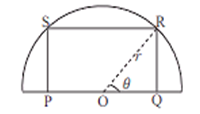A rectangle is inscribed in semicircle of ardius r with one of its sides on the diameter of the semicircle. Find the dimensions of the rectangle to get maximum area. Also, find the maximum area.
Let PQRS be the rectangle inscribed in the semi-circle of radius so that OR = r, where O is in centre of circle.
Let PO = OQ = x and QR = y so that sides of rectangle are of lengths 2x and 2y respectively.
Let

In ,
Let A be area of rectangle PQRS
= 2 OQ QR
=
= 0
is critical point.
< 0
Area is maximum at =
So, sides of rectangle are
And, Area = = r2 sq. units.
A bill for Rs. 7650 was drawn on 8th March, 2013, at 7 months. It was discounted on 18th May, 2013 and the holder of bill received Rs. 7497. What is the rate of interest charged by bank?
Given, Face value of bill = Rs. 7650 = A
Discounted value of the bill = Rs. 7497
Bankers discount = Rs. (7650 - 7497) = Rs. 153
Tenure = 7 Months
Nominal due date is 8th october.
Legally due date = Nominal due date + 3 days of grace
= 11th october
Number of unexpired days
| May | 13 |
| June | 30 |
| July | 31 |
| Aug | 31 |
| Sept | 30 |
| Oct | 11 |
| Total | 146 Days |
Thus, number of unexpired days from 8 May to 11 October is 146 days.
n = = years.
Bankers discount = A x n x i
153 = 7650 x i
Hence, the required rate of interest is 5 % per annum.
A firm has the cost function C = and demand function x = 100 - p
(i) Write the total revenue function in terms of x.
(ii) Formulate the total profit function P in terms of x.
(iii) Find the profit maximising level of output x.
(i) Total revenue function = x(100 - x)
Profit function = Revenue function - Cost function
= 100x - x2 - (x3/3 - 7x2 + 111x + 50)
= - x3/3 + 6x2 - 11x - 50
dP/dx = - x2 + 12x - 11
For maximum or minimum dP/dx = 0
x2 + 12x + 11 = 0
x = 1, 11
d2P/dx2 = - 2x + 12
= - 2 11 + 12
= - 10 < 0
Profit is maximum when x = 11
The demand function is x = where x is the number of units demanded and p is the price per unit. Find:
(i) The revenue function R in terms of p.
(ii) The price and the number
(i) Given, x =
Total revenue function = px
Revenue function =
R =
For maximum or minimum dR/dp = 0
(ii)
As - 4/3 < 0, R is maximum
Number of units x =
Hence, R is maximum when 4 units are demanded at the price of 6 per unit.
A company produces a commodity with Rs.24,000 fixed cost. The variable cost is estimated to be 25 % of the total revenue recovered on selling the product at a rate of Rs. 8 per unit. Find the following:
(i) Cost function
(ii) Revenue function
(iii) Breakeven point
Let x be the number of units produced and sold.
Price per unit = Rs. 8
Revenue function = R(x) = 8x
Variable cost of the x units = 25 % of 8x
= Rs. 2x
Total cost = c(x) = fixed cost + variable cost
Total cost = c(x) = 24000 + 2x
At break even point: R(x) = c(x)
